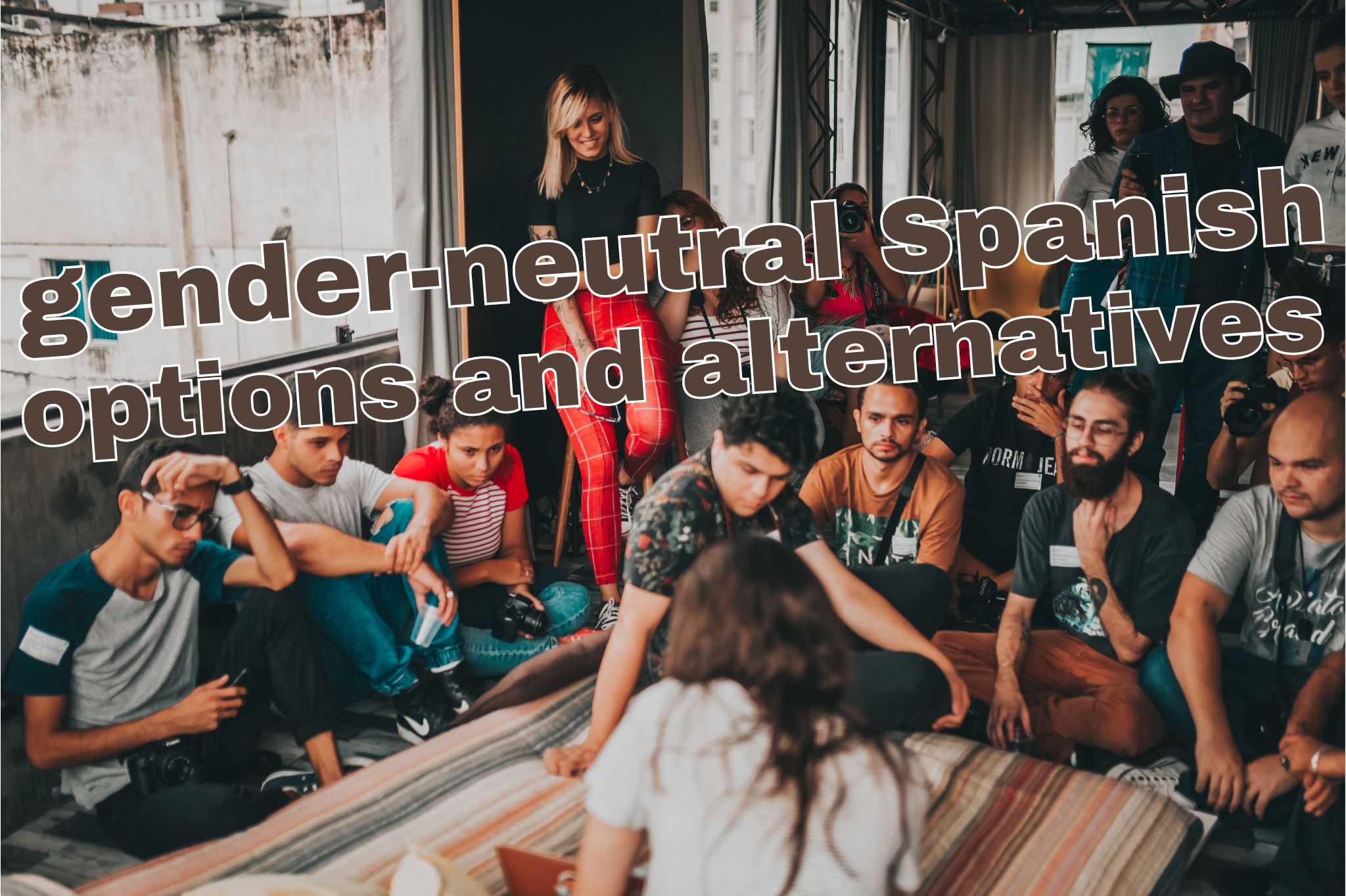Gender-Neutral Spanish: Options and Alternatives

Get our free email course, Shortcut to Conversational.
Have conversations faster, understand people when they speak fast, and other tested tips to learn faster.
More infoWhether you find yourself at the outset of your Spanish language journey or consider yourself an advanced learner, you’ve likely observed that gender distinctions are deeply entrenched in the Spanish language, where nouns and adjectives are invariably assigned masculine or feminine genders.
When it comes to referring to individuals, however, navigating these gendered conventions becomes a nuanced challenge, influenced by cultural customs and evolving societal perspectives.
As society’s perspectives and values evolve, so does language, as the two are intricately interconnected. Recent years have witnessed a growing interest among specific groups to carve out linguistic spaces within the Spanish language that transcend conventional gender norms, sparking both support and debate.
That’s why in today’s post, we aim to illuminate instances of gender-neutral Spanish that you may encounter, showcasing the ongoing dialogue surrounding linguistic inclusivity.
Gender-neutral Spanish: Origin
Gender-neutral Spanish refers to language modifications aimed at eliminating or minimizing gender distinctions, especially in instances where traditional Spanish grammar imposes gendered or male-oriented forms.
The purpose of gender-neutral Spanish, according to those who support it, is to create a more egalitarian and respectful linguistic environment by acknowledging and validating diverse gender expressions. It aims to break away from reinforcing gender stereotypes and promote a language that reflects the evolving understanding of gender within society.
To understand the motives behind a reform towards gender-neutral Spanish, we first need to understand how gender in Spanish works. For an introductory explanation of gender categorization in Spanish grammar, we recommend that you begin with our post on Spanish articles. In essence, every noun in the Spanish language has a gender, along with the adjectives that describe them.
This grammatical practice is straightforward enough when talking about objects or animals. When referring to people though, some feel that the language is not accurate enough, exhibiting a sexist bias that excludes non-binary identities. Let’s take a look at some of the ways that this happens.
Generic masculine: mixed groups
The generic masculine in Spanish refers to the common practice of using masculine forms of words to refer to both males and females in a general or mixed-gender context. This linguistic convention has been a traditional aspect of the Spanish language, where masculine forms are often considered inclusive of both genders. An example would be to use “amigos” to refer to a group of friends, regardless of their gender.
However, this conventional use of the generic masculine has faced increasing scrutiny due to its implications on gender inclusivity. Critics argue that relying on masculine forms as a default perpetuates a linguistic bias that marginalizes and reinforces traditional gender norms, and that the assumption that the masculine encompasses both genders can inadvertently contribute to the erasure of female and non-binary identities within language.
Generic masculine: professions
This generic masculine practice extends to professions as well, with some choosing to use masculine nouns and adjectives even when referring to women, particularly in fields traditionally dominated by men. Over time, efforts have been made to introduce female counterparts for various professions. However, a notable issue persists, as some of these female equivalents carry different, and often less prestigious, connotations.
Take, for instance, the term “secretaria,” which is commonly used to denote an administrative assistant or typist, typically associated with women. In contrast, the masculine form “secretario” is reserved for a high-ranking position within a political institution, typically held by a man.
Gender-neutral Spanish: Alternatives
Now let’s explore various alternatives that are gaining traction to mitigate gender bias in Spanish.
The majority of these alternatives align with Spanish grammar rules and are generally considered acceptable. However, certain approaches, such as incorporating symbols or swapping letters, face more criticism, as they deviate from traditional Spanish grammar norms.
Let’s delve into these linguistic alternatives and examine how they navigate the balance between inclusivity and adherence to established grammatical conventions.
Splitting
Instead of defaulting to the generic masculine when addressing a mixed-gender group, opting for gendered terms for each individual can mitigate sexist undertones. However, it’s crucial to note that this approach may still inadvertently exclude individuals who identify with non-binary genders.
Compare these two examples to see how splitting can be more inclusive than relying on the generic masculine:
- Debemos garantizar que se cumplan los derechos de los ciudadanos. – We must guarantee the rights of the citizens.
- Debemos garantizar que se cumplan los derechos de los ciudadanos y las ciudadanas. – We must guarantee the rights of male and female citizens.
Collective nouns
Using collective nouns that inherently include both genders can help to avoid specifying binary genders.
Compare these examples, where the collective noun for the team inherently includes all genders better than the generic masculine for the players:
- Los jugadores deben estar en buen estado físico. – Players must be in good physical condition.
- El equipo debe estar en buen estado físico. – The team must be in good physical condition.
Periphrasis
Periphrasis involves expressing an idea in a roundabout way, often using additional words to avoid gendered terms.
Here’s an example where we refer inclusively to people who lead, rather than the general (masculine) leaders:
- Los líderes del partido están planificando su próxima estrategia. – The party leaders are planning their next strategy.
- Las personas que lideran el partido están planificando su próxima estrategia. – The people leading the party are planning their next strategy.
Metonymy
Metonymy substitutes a word with one closely associated with it, allowing for a more gender-neutral expression.
In this example, we refer to the coordination team rather than to the coordinators themselves:
- Es responsabilidad de los coordinadores hacer una reunión mensual por departamento. – It is the coordinators’ responsibility to hold a monthly meeting per department.
- Es responsabilidad de la coordinación hacer una reunión mensual por departamento. – It’s the coordination’s responsibility to hold a monthly meeting per department.
Apposition
Apposition involves placing two elements side by side to provide additional information, allowing for gender-neutral descriptions.
- Todos los estudiantes, de uno u otro sexo, deben acoplarse a las reglas de la institución. – All students, of either sex, must abide by the rules of the institution.
Switching determiners
At times, omitting or swapping specific gendered determiners (such as articles, possessives, demonstratives, numerals, or certain interrogatives like cuanto/cuanta) with ungendered alternatives can establish a more neutral expression. However, it’s important to note that this strategy is applicable only to nouns that do not vary in gender.
Determinants like los and todos are inherently masculine:
- Solo los estudiantes con buenos promedios pueden aplicar a la beca. – Only the students with good grades can apply for the scholarship.
- Todos los estudiantes deben presentar el examen. – All students must take the exam.
Alternatives are to use no determinant at all, or to use ungendered options such as cada:
- Solo estudiantes con buenos promedios pueden aplicar a la beca. – Only students in good standing may apply for the scholarship.
- Cada estudiante debe presentar el examen. – Every student must take the exam.
Dropping the gendered subject
Dropping the subject in gender-neutral Spanish involves omitting the gendered subject from a sentence, allowing the action or verb to stand independently without specifying the gender of the person performing it.
This can apply to gendered direct or indirect objects as well, as we see in our example:
- Cualquier desperfecto del producto debe ser reportado por el consumidor de inmediato. – Any product malfunction should be reported by the consumer immediately.
- Cualquier desperfecto del producto debe ser reportado de inmediato. – Any product malfunction should be reported immediately.
The suffix -e and gender-neutral pronouns
One of the most contentious proposals regarding gender-neutral Spanish involves replacing the gendered suffixes -a or -o with -e in gendered articles, nouns, and adjectives.
This same solution is applied to subject pronouns to create gender-neutral pronouns in Spanish. Elle is the gender-neutral alternative to él and ella, for example. The use of these pronouns would be the closest equivalent to they/them in Spanish.
Here’s the whole set of Spanish gender-neutral pronouns using the suffix -e:
| masculine pronoun | feminine pronoun | gender-neutral pronoun |
| él | ella | elle |
| ellos | ellas | elles |
| nosotros | nosotras | nosotres |
| vosotros | vosotras | vosotres |
The objective of this practice is to be inclusive of those who identify as nonbinary, and to rectify the perceived bias in the Spanish language that favors the masculine form by default.
- Elle es mi mejor amigue. – They’re my best friend.
- Les doctores están trabajando. – The doctors are working.
- Nosotres somos muy altes. – We are very tall.
Using symbols
Another frequently encountered yet contentious option is the utilization of symbols like @, *, or the letter x instead of the standard gendered suffixes. The primary concern with this approach is the lack of clarity in pronunciation, coupled with the fact that these symbols are not inherent to Spanish morphology.
- L@s niñ@s. – The kids.
- Lxs latinx. – Latinos and Latinas
- Ell*s estan protestando. – They’re protesting.

Using gender-neutral symbols, as here with lxs vecin@s to refer to the neighbors, is very common among community groups
Conclusion: Gender-neutral Spanish
Now that we’re finished, let’s do a quick wrap-up of everything we learned regarding gender neutrality in Spanish.
First, we learned that the quest for gender-neutral Spanish reflects a dynamic interplay between language, culture, and evolving societal attitudes. The origins of gender-neutral Spanish stem from the desire of an increasing proportion of society to create a less male-oriented linguistic environment and to represent gender identities outside the norm.
Various alternatives have been proposed to mitigate gender bias in Spanish, each with its merits and challenges. While some alternatives align more closely with established Spanish grammar rules, others, such as the use of symbols or the suffix -e to replace gendered suffixes, face resistance due to concerns about clarity and adherence to linguistic traditions.
The pursuit of gender-neutral language is an ongoing and nuanced discussion. Whether we find ourselves in agreement or disagreement with these linguistic changes, cultivating an awareness of them and the motivations behind them enriches our understanding of language as a reflection of societal values.
We hope you enjoyed today’s post! See you soon for more Spanish content!



